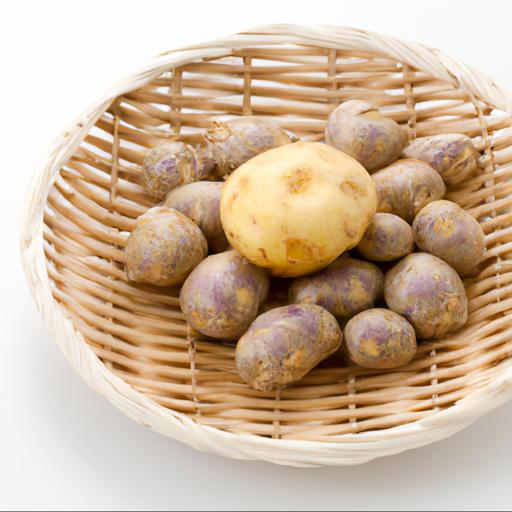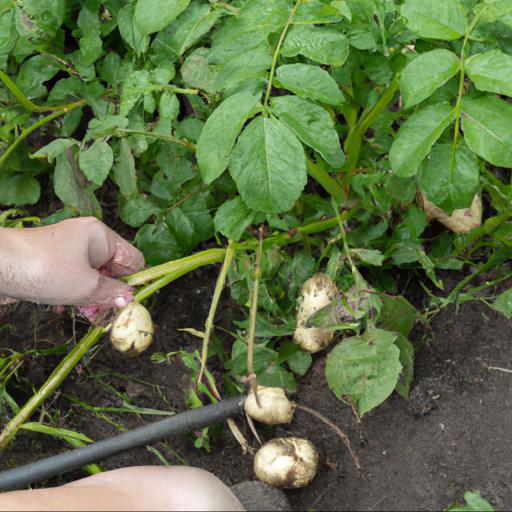Solanum tuberosum Desiree is a popular potato variety that is widely grown and consumed around the world. This type of potato is known for its unique color, flavor, and texture. It is a great choice for a variety of recipes, including mashed potatoes, chips, and even baked potatoes.
It is also a favorite among gardeners due to its easy maintenance and resistance to disease. In this article, we will explore the history, characteristics, and uses of Solanum tuberosum Desiree potatoes.
We will also discuss some of the benefits of growing and consuming this variety.
Nutritional benefits of solanum tuberosum desiree

The potato (Solanum tuberosum desiree) is a nutritious and versatile vegetable. It is a popular source of vitamins, minerals, and other essential nutrients for people around the world.
Native to the Andes mountains in South America, the potato is prized for its versatility and ability to adapt to a variety of cooking techniques. This makes it an ideal food for both vegetarians and non-vegetarians alike. The potato is composed of complex carbohydrates and is a good source of dietary fiber.
Its low-glycemic index makes it a preferred food for diabetics, and its high-potassium content helps to maintain normal blood pressure levels. It is also a good source of vitamins B6 and C, iron, calcium, and magnesium. These vitamins and minerals are necessary for optimal health and provide numerous other benefits as well.
When eaten with the skin, the potato is a great source of antioxidants, which can help protectagainst oxidation damage. The skin also helps to retain the natural flavors of the potato as well as its fiber and nutrient content.
Moreover, eating potatoes with their skin helps to promote digestive health. This is because potatoes are rich in resistant starch, which acts as a type of prebiotic and helps to feed the beneficial bacteria living in the digestive tract. All in all, potatoes are a healthy and nutritious food choice for people of all ages.
They are highly versatile and can be prepared in various different ways. Whether you boil them, bake them, mash them, or fry them, the potato is sure to be an excellent addition to any meal.
So the next time you’re wondering what to cook, why not make it a potato? It’s sure to please your palate and provide your body with the nutritional benefits it needs.
Growing and harvesting solanum tuberosum desiree

Growing and harvesting Solanum tuberosum Desiree can be an incredibly rewarding, yet challenging gardening pastime to take part in. A popular variety of potato, this particular vegetable has an earthy, sweet, and full-bodied aroma.
Not to mention, it is a great source of several vitamins, minerals, and dietary fiber, making it a nutritional powerhouse!Harvesting and planting season for Solanum tuberosum Desiree begins in late spring/early summer, depending on your location and weather conditions. This particularly robust and hardy crop enjoys rich and well-draining soil, meaning you should add manure, compost, and other organic matter to your soil before planting.
If possible, cover the area with black plastic and let it sit in the sun to heat the soil. Once the soil is ready, the planting can begin!
Don’t forget to leave adequate space between the seed potatoes, as they can grow quite large. Taking good care of your Solanum tuberosum Desiree is essential for a good crop at the end of the season. During the growing season, it is important to make sure the plants are getting enough water and fertilizer to stay healthy.
Additionally, you should protect them from pests such as aphids, flea beetles, and blight. Harvest time for Solanum tuberosum Desiree typically occurs between the months of August and October and should take place when the potatoes are fully mature. The best way to know when it is time for harvest is to carefully observe the leafy tops of the plants – when the foliage begins to yellow and die back, the potatoes are ready for pulling.
By following these few steps, you should be able to find yourself enjoying a great crop at the end of the season!
Cooking with solanum tuberosum desiree
Cooking with Solanum tuberosum desiree is a rewarding culinary experience. Part of the family of potatoes, this heart-shaped potato has a deep, yellow-orange flesh with a creamy texture. It is particularly noted for its potato-like flavorful nuttiness and its excellent baking qualities.
While Solanum tuberosum can be cooked in a variety of methods, baking and roasting are the best for achieving it’s most flavorfull profile. Baking Solanum tuberosum is an excellent way to bring out its natural sweetness and its creamy texture.
The most popular way to bake it is to cut it into wedges and season generously with olive oil, salt, and pepper. Roasting in a hot oven brings out the nuttiness of the potato. To achieve crunchy roasted potatoes, pre-cook them in simmering water for five to ten minutes, strain and pat dry, then toss them in oil, salt, and other spices.
Place them on a parchment-lined baking tray and bake at a high temperature of 425 – 450 degrees Fahrenheit for 20-25 minutes, flipping halfway through. Though Solanum tuberosum’s flavor and texture make it an ideal choice for baking and roasting, this potato is also great in soups and stews.
The addition of its creamy flesh to hearty broths enhances the flavor of the soup and its high starch content helps to thicken the broth. It is also an excellent choice for making mashed potatoes, as its high starch content makes for a smooth, creamy mash. What’s also great about Solanum tuberosum desiree is that any leftovers can be used in potato salads or fried in a skillet to make delicious hash browns.
No matter how you choose to make it, cooking with Solanum tuberosum desiree is a rewarding experience. Not only does it bring out the best in any dish you make, but its robust flavor and creamy texture make it the go-to choice for a heavenly feast.
Health benefits of solanum tuberosum desiree
Solanum tuberosum desiree is a type of edible tuber, also known as potato, that is popular all around the world. With its vigorous production traits, moderate starch content and smooth texture, this tuber is an excellent choice for gardeners looking for exceptional yields in their crops.
Beyond its production benefits, however, Solanum tuberosum desiree also contains several nutrients that can provide health benefits. This type of potato contains high levels of dietary fiber and several minerals and vitamins, such as Vitamin C and Vitamin B Due to this composition, researchers have found that consuming Solanum tuberosum desiree can improve digestive health, reduce cholesterol levels and reduce the risk of Type 2 diabetes.
Moreover, consuming potatoes of the Solanum tuberosum desiree variety has been linked to improved blood pressure and heart health. Potatoes contain a certain type of phenolic compounds – known as ‘antinutrients’ – that have been shown to reduce the risk of strokes and heart disease.
For this reason, dieticians often recommend including potatoes of this variety in heart health diets. In conclusion, Solanum tuberosum desiree potatoes can provide significant health benefits to those who eat it. Not only do they produce high yields and contain naturally sweet, creamy flesh, they also contain beneficial vitamins and minerals, such as Vitamin C and Vitamin B
Furthermore, the phenolic compounds present in this type of potato can improve heart health, reduce cholesterol levels and even improve blood pressure. All in all, Solanum tuberosum desiree is an excellent choice for gardeners and health-conscious individuals alike.
Our video recommendation
Final Touch
Solanum tuberosum Desiree is a popular potato variety that is widely grown in Europe and North America. It is a mid-season variety, with a high yield and good storage potential.
The tubers are oval-shaped and slightly flattened, with a bright yellow skin and creamy yellow flesh. It is a good all-purpose potato, suitable for boiling, baking, mashing, and roasting. Its waxy texture and sweet flavour make it an excellent choice for salads and other dishes.
FAQ
What are the nutritional benefits of Solanum tuberosum Desiree?
Solanum tuberosum Desiree is a type of potato that is high in nutrients. It is a good source of fiber, vitamins C and B6, potassium, and magnesium. It also contains a variety of phytonutrients, including carotenoids, which may have antioxidant and anti-inflammatory properties. Additionally, Solanum tuberosum Desiree is low in fat and calories, making it a healthy choice for those looking to lose or maintain weight.
How does Solanum tuberosum Desiree compare to other potato varieties?
Solanum tuberosum Desiree is a mid-season potato variety that is known for its creamy yellow flesh and its good baking qualities. It is a good all-purpose potato and is suitable for boiling, mashing, roasting, and baking. Compared to other potato varieties, Solanum tuberosum Desiree is known for its good flavor and texture, and its ability to hold its shape when cooked.
What is the best way to cook Solanum tuberosum Desiree?
The best way to cook Solanum tuberosum Desiree is to boil or bake it. Boiling is the quickest and easiest way to cook it, while baking is a more flavorful option. Both methods will result in a delicious and nutritious side dish.
What are the common diseases that affect Solanum tuberosum Desiree?
Common diseases that affect Solanum tuberosum Desiree include late blight, common scab, blackleg, and bacterial wilt.
How long does it take for Solanum tuberosum Desiree to mature?
Solanum tuberosum Desiree typically takes around 90-120 days to mature.
What is the optimal soil type for growing Solanum tuberosum Desiree?
The optimal soil type for growing Solanum tuberosum Desiree is a well-drained, fertile soil with a pH of 6.0-7.0.

